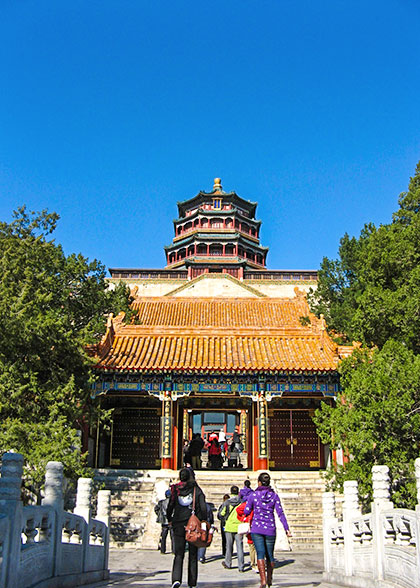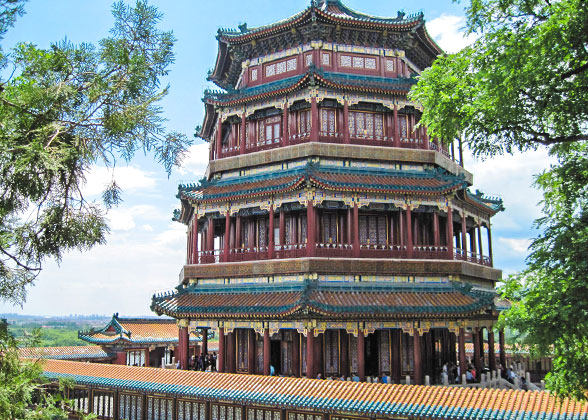Tower of Buddhist Incense (Foxiangge)
The Tower of Buddhist Incense is the highest point of the Summer Palace, serving not only as the architectural centerpiece of this imperial garden but also as the best vantage point to overlook Kunming Lake and the entire palace complex.
|
|
What does the Tower of Buddhist Incense look like?
Clad in yellow glazed tiles trimmed with green, the tower features an octagonal shape, three stories and four-layer eaves converging into a pointed roof. Supported by eight ironwood pillars, each one meter in diameter, and surrounded by 24 vermilion corridor pillars, it showcases the peak of Qing Dynasty wooden architecture.
Approach close to the gate of the tower's ground floor, you'll see a gilded bronze Thousand-Armed Avalokiteshvara (a compassionate Buddha) statue cast in 1574. The statue boasts twelve faces and twenty-four arms, seated on a throne adorned with 999 blooming lotus flowers across nine layers.
Surrounding the tower are porch rooms with south and the north gates decorated with yellow glazed tiles and green brims, from which you can admire the tower from different aspects. From a distance, the tower faces Kunming Lake to the south, stands adjacent to the Wisdom Sea Hall to the north, and is flanked by symmetrical buildings on both wings, forming a "stars surrounding the moon" layout.
 |
| Thousand-Armed Avalokiteshvara |
Surrounding the tower are porch rooms with south and the north gates decorated with yellow glazed tiles and green brims, from which you can admire the tower from different aspects. From a distance, the tower faces Kunming Lake to the south, stands adjacent to the Wisdom Sea Hall to the north, and is flanked by symmetrical buildings on both wings, forming a "stars surrounding the moon" layout.
|
|
History
The Tower of Buddhist Incense originated from the Prolonging Longevity Pagoda. In 1750, inspired by the Six Harmony Pagoda he saw during a southern tour, Emperor Qianlong (1711~1799) ordered the construction of Prolonging Longevity Pagoda. In 1758, the project was abandoned due to the excessive weight of its brick construction materials.
 |
| Tower of Buddhist Incense |
Ghost Tale behind the Tower of Buddhist Incense
It is said that during the construction of the Prolonging Longevity Pagoda, workers unearthed an ancient tomb of a concubine from the previous dynasty at the foot of the Longevity Hill. Emperor Qianlong visited the site and ordered the opening of the tomb.
On the tomb door back, an inscription read: "Leave me undisturbed, and I shall leave you in peace." Stricken with awe, Qianlong immediately sealed the tomb and decided to build the Tower of Buddhist Incense atop it. Compared to the Prolonging Longevity used only for enshrining Buddhist statues and texts, this newly built tower was believed to own the Buddhist power to quell any restless spirits.
Tips for Visiting Tower of Buddhist Incense
2. The time to reach the tower varies based on fitness level, as there are over 400 high and steep steps. Visitors in good physical condition can reach the top in approximately 10 minutes, while the average visitor typically takes 20–30 minutes. Comfortable clothing and non-slip shoes are recommended for the climb.
3. During holidays, expect over 40 minutes of queuing to climb the main hall staircase. To reduce waiting time, visit before 8:30 or after 16:00, and avoid the peak hours between 10:00 and 14:00.
![]() Next: Pavilion of Treasure Clouds
Next: Pavilion of Treasure Clouds
![]() Related Link: Summer Palace Travel Tips
Related Link: Summer Palace Travel Tips
- Last updated on Oct. 23, 2025 by Jally Zhang -



